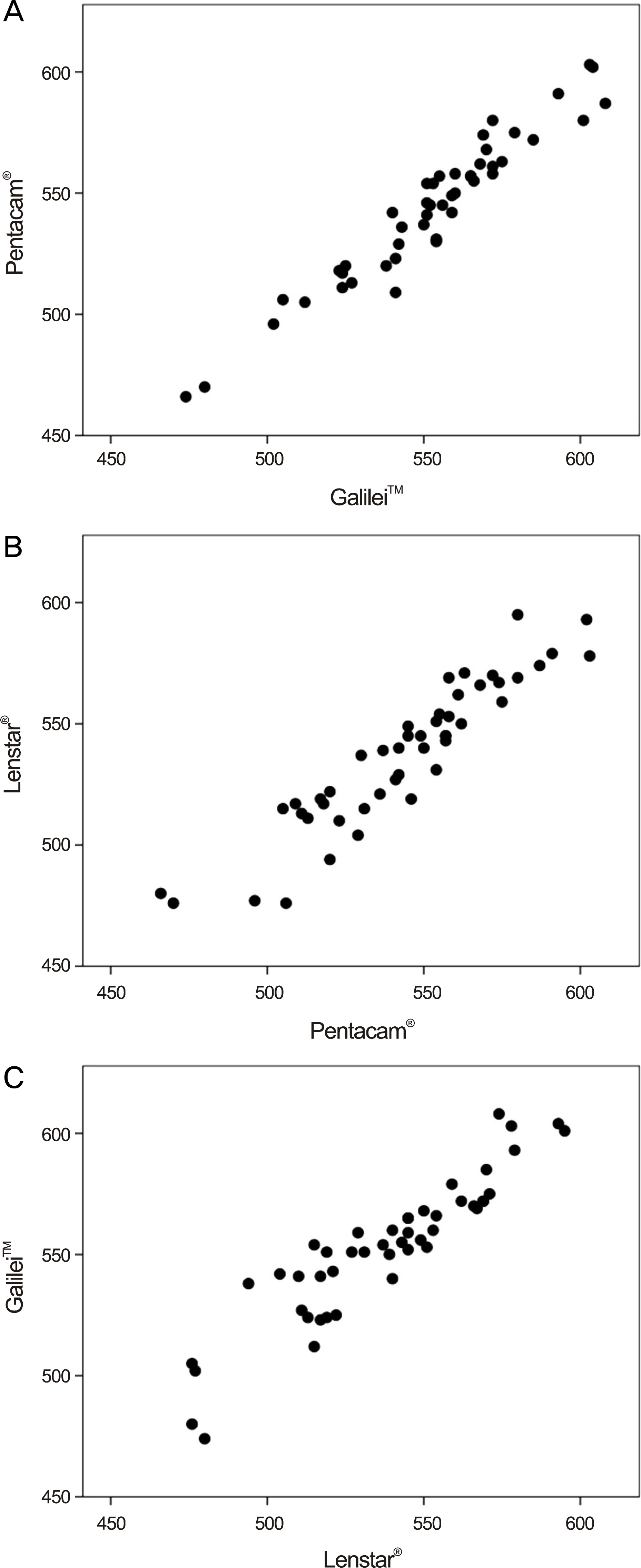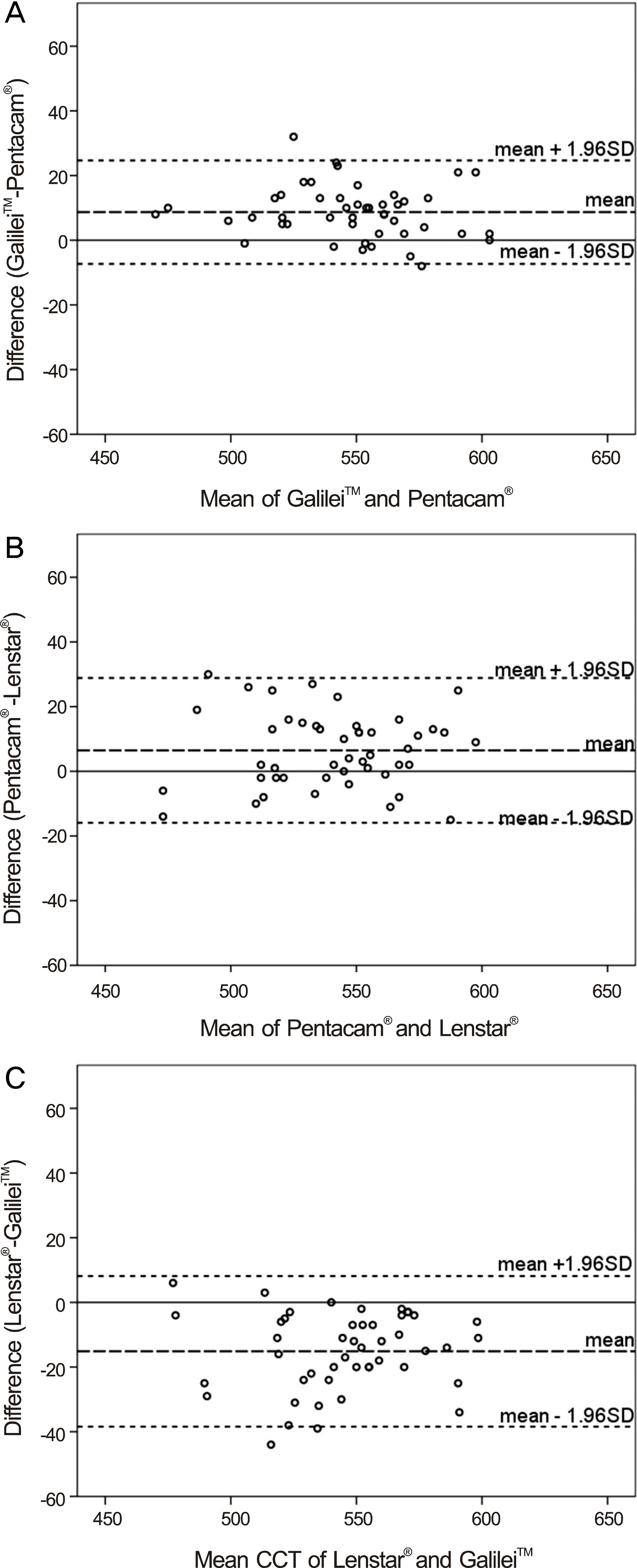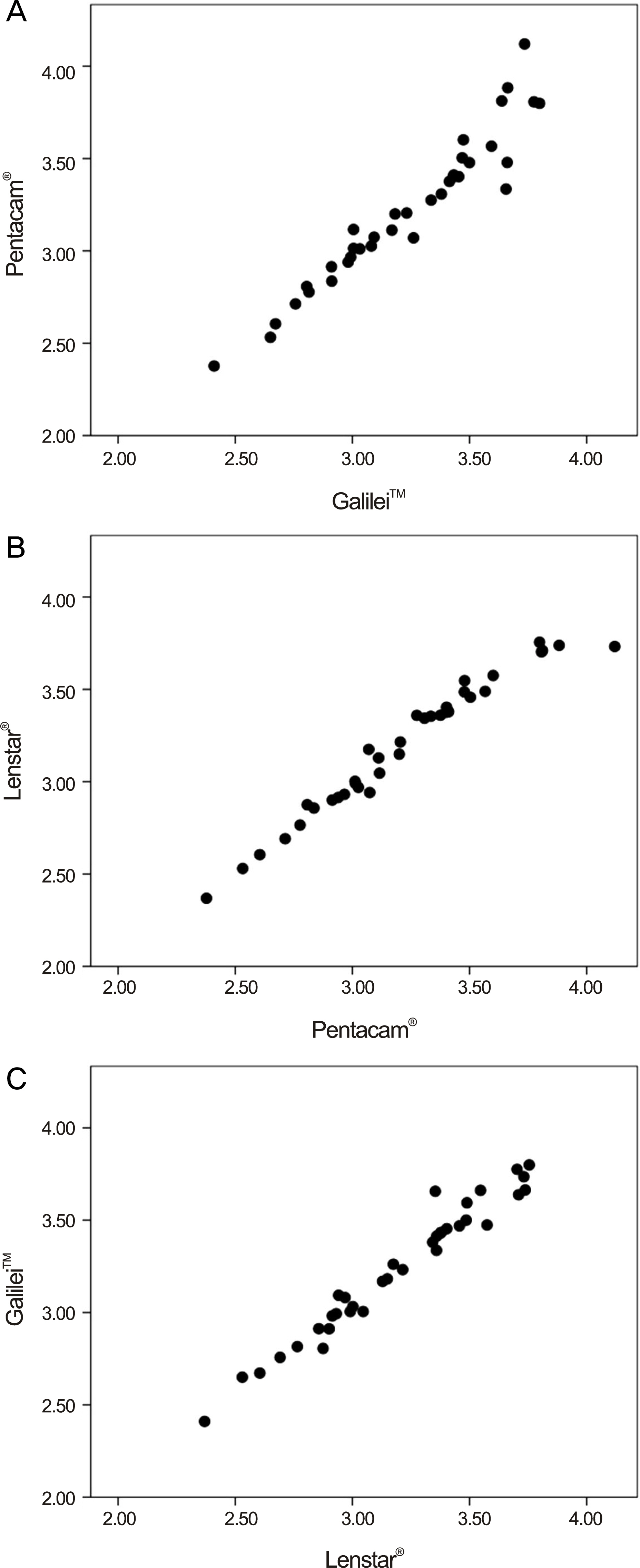J Korean Ophthalmol Soc.
2015 May;56(5):694-701. 10.3341/jkos.2015.56.5.694.
Comparison of Central Corneal Thickness and Anterior Chamber Depth Measured Using Three Different Devices
- Affiliations
-
- 1Department of Ophthalmology, Chuncheon Sacred Heart Hospital, Hallym University College of Medicine, Chuncheon, Korea. hkeoph@gmail.com
- KMID: 2121166
- DOI: http://doi.org/10.3341/jkos.2015.56.5.694
Abstract
- PURPOSE
To compare measurements of central corneal thickness (CCT) and anterior chamber depth (ACD) obtained using Galilei(TM), Pentacam(R) (Oculus, Wetzlar, Germany) and Lenstar(R) (Haag-Streit, Koeniz, Switzerland) and analyze the measurement agreements.
METHODS
CCT and ACD were measured using Galilei(TM), Pentacam(R) and Lenstar(R) in 47 eyes of 25 healthy subjects. The measurements were compared among the 3 devices.
RESULTS
The average CCT measurements using Galilei(TM), Pentacam(R) and Lenstar(R) were 552.6 +/- 29.41 microm, 543.9 +/- 30.50 microm and 537.5 +/- 30.26 microm, respectively. The measurements significantly correlated with each other (r > 0.9, p < 0.001), but were statistically significantly different (p < 0.001). The average ACD measurements using Galilei(TM), Pentacam(R) and Lenstar(R) were 3.23 +/- 0.360 mm, 3.22 +/- 0.403 mm and 3.19 +/- 0.367 mm, respectively. The measurements significantly correlated with each other (r > 0.9, p < 0.001), but were statistically significantly different (p = 0.034). The CCT 95% limits of agreement (LoA) between Galilei(TM) and Pentacam(R), Pentacam(R) and Lenstar(R) and Lenstar(R) and Galilei(TM) were 31.95 microm, 44.76 microm and 46.57 microm, respectively and 95% ACD LoA were 0.46 mm, 0.32 mm and 0.28 mm, respectively.
CONCLUSIONS
CCT and ACD measured using the 3 devices were highly correlated with each other but the measurements were statistically different. Therefore, the measurements were not interchangeable and these differences should be considered in clinical use.
MeSH Terms
Figure
Cited by 1 articles
-
Comparison of Anterior Segment Measurements between Dual and Single Scheimpflug Camera
Youngju An, Hyojin Kim, Choun-Ki Joo
J Korean Ophthalmol Soc. 2016;57(7):1056-1062. doi: 10.3341/jkos.2016.57.7.1056.
Reference
-
References
1. Reddy AR, Pande MV, Finn P, El-Gogary H. Comparative estimation of anterior chamber depth by ultrasonography, Orbscan II, and IOLMaster. J Cataract Refract Surg. 2004; 30:1268–71.
Article2. Vetrugno M, Cardascia N, Cardia L. Anterior chamber depth measured by two methods in myopic and hyperopic phakic IOL implant. Br J Ophthalmol. 2000; 84:1113–6.
Article3. Olsen T. Sources of error in intraocular lens power calculation. J Cataract Refract Surg. 1992; 18:125–9.
Article4. Savini G, Carbonelli M, Barboni P, Hoffer KJ. Repeatability of au-tomatic measurements performed by a dual Scheimpflug analyzer in unoperated and post-refractive surgery eyes. J Cataract Refract Surg. 2011; 37:302–9.
Article5. Jasvinder S, Khang TF, Sarinder KK, et al. Agreement analysis of LENSTAR with other techniques of biometry. Eye (Lond). 2011; 25:717–24.
Article6. Anayol MA, Güler E, Yağc R, et al. Comparison of central corneal thickness, thinnest corneal thickness, anterior chamber depth, and simulated keratometry using galilei, Pentacam, and Sirius devices. Cornea. 2014; 33:582–6.
Article7. Borrego-Sanz L, Sáenz-Francés F, Bermudez-Vallecilla M, et al. Agreement between central corneal thickness measured using Pentacam, ultrasound pachymetry, specular microscopy and optic biometer Lenstar LS 900 and the influence of intraocular pressure. Ophthalmologica. 2014; 231:226–35.
Article8. Huang J, Ding X, Savini G, et al. Central and midperipheral corneal thickness measured with Scheimpflug imaging and optical coherence tomography. PLoS One. 2014; 9:e98316.
Article9. Huang J, Ding X, Savini G, et al. A Comparison between Scheimpflug imaging and optical coherence tomography in measuring corneal thickness. Ophthalmology. 2013; 120:1951–8.
Article10. Huang J, Pesudovs K, Wen D, et al. Comparison of anterior segment measurements with rotating Scheimpflug photography and partial coherence reflectometry. J Cataract Refract Surg. 2011; 37:341–8.
Article11. Huerva V, Ascaso FJ, Soldevila J, Lavilla L. Comparison of anterior segment measurements with optical low-coherence reflectometry and rotating dual Scheimpflug analysis. J Cataract Refract Surg. 2014; 40:1170–6.
Article12. OʼDonnell C, Hartwig A, Radhakrishnan H. Comparison of central corneal thickness and anterior chamber depth measured using LenStar LS900, Pentacam, and Visante AS-OCT. Cornea. 2012; 31:983–8.13. Salouti R, Nowroozzadeh MH, Zamani M, et al. Comparison of anterior chamber depth measurements using Galilei, HR Pentacam, and Orbscan II. Optometry. 2010; 81:35–9.
Article14. Tai LY, Khaw KW, Ng CM, Subrayan V. Central corneal thickness measurements with different imaging devices and ultrasound pachymetry. Cornea. 2013; 32:766–71.
Article15. Uçakhan OÖ, Akbel V, Bıyıklı Z, Kanpolat A. Comparison of corneal curvature and anterior chamber depth measurements using the manual keratometer, Lenstar LS 900 and the Pentacam. Middle East Afr J Ophthalmol. 2013; 20:201–6.
Article16. Hernández-Camarena JC, Chirinos-Saldaña P, Navas A, et al. Repeatability, reproducibility, and agreement between three different Scheimpflug systems in measuring corneal and anterior segment biometry. J Refract Surg. 2014; 30:616–21.
Article17. Lopez de la Fuente C, Sanchez-Cano A, Segura F, et al. Repeatability of ocular measurements with a dual-Scheimpflug analyzer in healthy eyes. Biomed Res Int. 2014; 2014:808646.
Article18. Wang Q, Ding X, Savini G, et al. Anterior chamber depth measurements using Scheimpflug imaging and optical coherence tomography: repeatability, reproducibility, and agreement. J Cataract Refract Surg. 2015; 41:178–85.
Article19. Shammas HJ, Hoffer KJ. Repeatability and reproducibility of biometry and keratometry measurements using a noncontact optical low-coherence reflectometer and keratometer. Am J Ophthalmol. 2012; 153:55–61.e2.
Article20. Bayhan HA, Aslan Bayhan S, Can I. Comparison of central corneal thickness measurements with three new optical devices and a standard ultrasonic pachymeter. Int J Ophthalmol. 2014; 7:302–8.21. Bland JM, Altman DG. Statistical methods for assessing agreement between two methods of clinical measurement. Lancet. 1986; 1:307–10.
Article22. Bland JM, Altman DG. Measurement error. BMJ. 1996; 313:744.23. Doughty MJ, Zaman ML. Human corneal thickness and its impact on intraocular pressure measures: a review and meta-analysis approach. Surv Ophthalmol. 2000; 44:367–408.24. Holladay JT. Standardizing constants for ultrasonic biometry, keratometry, and intraocular lens power calculations. J Cataract Refract Surg. 1997; 23:1356–70.
Article25. Kim YY, Jung HR. Clarifying the nomenclature for primary angle-closure glaucoma. Surv Ophthalmol. 1997; 42:125–36.
Article26. Crawford AZ, Patel DV, McGhee CN. Comparison and repeatability of keratometric and corneal power measurements obtained by Orbscan II, Pentacam, and Galilei corneal tomography systems. Am J Ophthalmol. 2013; 156:53–60.
Article27. Aramberri J, Araiz L, Garcia A, et al. Dual versus single Scheimpflug camera for anterior segment analysis: precision and agreement. J Cataract Refract Surg. 2012; 38:1934–49.
Article
- Full Text Links
- Actions
-
Cited
- CITED
-
- Close
- Share
- Similar articles
-
- A Consideration for Corneal Curvature, Its Thickness and Anterior Chamber Depth
- Comparison of Corneal Thickness and Anterior Chamber Depth Measured With Orbscan, Pentacam, and Ultrasound Pachymetry
- Comparison of Anterior Segment Parameters Obtained by Anterior Segment Optical Coherence Tomography and Dual Rotating Scheimpflug Camera
- Measurement of Anterior Segment Using Visante OCT in Koreans
- Anterior Chamber Depth, Corneal Thickness and Corneal Endothelial Change following Decreased Intraocular Pressure





